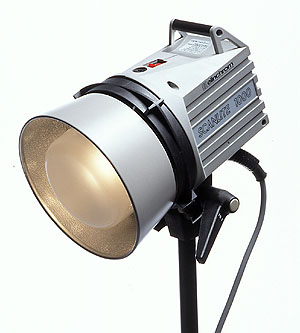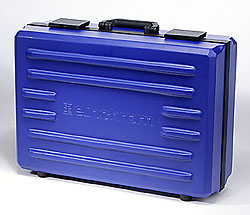Elinchrom Scanlites
For the last six months we have been using Systems Imaging Scandles
fluorescent studio lighting heads for digital product photography with our
Leaf Lumina scan-camera. Prior to that, we used two redhead tungsten
lights (800W each) and the Scandles substantially improved exposure times,
colour quality, freedom from image noise and the temperature in the
studio.
 Elinca's new Scanlite 1000 heads are intended to compete with
cool-running fluorescent heads by offering a higher maximum wattage than a
redhead, the halogen bulb encased in an optional opal diffusing dome, with
the benefit of Elinchrom reflector and softbox compatibility.
Elinca's new Scanlite 1000 heads are intended to compete with
cool-running fluorescent heads by offering a higher maximum wattage than a
redhead, the halogen bulb encased in an optional opal diffusing dome, with
the benefit of Elinchrom reflector and softbox compatibility.
We tested a pair of Scanlites, which come in a tiny blue fitted case and
must be the smallest, lightest 1kW lighting heads around. They are also
intended for video work and conventional still photography - the name
simply reflects their special suitability, compared to lower power halogen
lights, for digital scan cameras such as the Lumina, Praktica, Agfa
StudioCam and Photophase. These are the digital still life cameras most
likely to be bought by new entrants to electronic photography, as they
cost from under �3,000.
The Scanlite's compact plastic body has a permanently running fan which
is very quiet. At the front is an Elinchrom bayonet mount, but the
protective dome rules out some older reflectors with narrow waists. We
used a spill-kill; a deep parabolic, which projected too much heat; and a
1m softbox, which tripped the thermal cutout of the head at intervals when
aimed downwards. To prevent this the diffuser dome can be removed, or
lower wattage 200W, 300W and 650W bulb options used.
This vital cut-out makes 1kW bulbs less usable for scanning, where times
may be from several seconds to a few minutes. If a head should cut off
during exposure, the scan is ruined. The head, once the cut-out trips, may
appear to be 'off'. It is not, and comes back on automatically when it
cools. A manual reset button would avoid the possibility of leaving the
head switched on by mistake.
In terms of scan times, the 1kW bulbs in reflectors proved unexpectedly
powerful - a shot which took a minute lit by full power Scandles from the
same distances needed just eight seconds. The power was so high the
Lumina was unable to balance the colour, R and G channels being at minimum
4.5ms exposure when B was at 5.5ms. A single 1kW in the softbox needed 3
minutes (R49.9ms, G54.8ms, B159.9ms), but did a far better job with the
terribly difficult subject we picked as a test. Moving the softbox as
close as physically possible without appearing in the shot, and adding the
second head direct from a distance, cut exposure down to thirty seconds
but gave rather high contrast.
View the results
The studio did become very hot, and the Elinchrom light table perspex
occasionally "popped" as it warmed under the lights. This is inevitable
with 650W or 1kW bulbs, if not with 200-300W.
 In conclusion, we felt the Scanlites with reflectors and large softbox
give much-needed light control and quality, but unlike fluorescent sources
can not be used all day for intensive work like digital catalogue
shooting. They are an inexpensive route to quiet, portable (two heads can
be packed in the blue case shown and fit under an airline seat) video and film
lighting and make perfect mixed lighting partners for Elinchrom flash.
They tackle flat artwork and large area subjects better than most
fluorescent heads.
In conclusion, we felt the Scanlites with reflectors and large softbox
give much-needed light control and quality, but unlike fluorescent sources
can not be used all day for intensive work like digital catalogue
shooting. They are an inexpensive route to quiet, portable (two heads can
be packed in the blue case shown and fit under an airline seat) video and film
lighting and make perfect mixed lighting partners for Elinchrom flash.
They tackle flat artwork and large area subjects better than most
fluorescent heads.
For the cost of two fluorescent heads you can buy four Scanlites with
650W bulbs and run them from a single 13 amp plug. This makes a versatile
lighting kit for today's tungsten-tolerant digital scan cameras - and a
superb system for conventional industrial, still life and video work.
- David Kilpatrick
Return to Photon September 96 contents
 Elinca's new Scanlite 1000 heads are intended to compete with
cool-running fluorescent heads by offering a higher maximum wattage than a
redhead, the halogen bulb encased in an optional opal diffusing dome, with
the benefit of Elinchrom reflector and softbox compatibility.
Elinca's new Scanlite 1000 heads are intended to compete with
cool-running fluorescent heads by offering a higher maximum wattage than a
redhead, the halogen bulb encased in an optional opal diffusing dome, with
the benefit of Elinchrom reflector and softbox compatibility. In conclusion, we felt the Scanlites with reflectors and large softbox
give much-needed light control and quality, but unlike fluorescent sources
can not be used all day for intensive work like digital catalogue
shooting. They are an inexpensive route to quiet, portable (two heads can
be packed in the blue case shown and fit under an airline seat) video and film
lighting and make perfect mixed lighting partners for Elinchrom flash.
They tackle flat artwork and large area subjects better than most
fluorescent heads.
In conclusion, we felt the Scanlites with reflectors and large softbox
give much-needed light control and quality, but unlike fluorescent sources
can not be used all day for intensive work like digital catalogue
shooting. They are an inexpensive route to quiet, portable (two heads can
be packed in the blue case shown and fit under an airline seat) video and film
lighting and make perfect mixed lighting partners for Elinchrom flash.
They tackle flat artwork and large area subjects better than most
fluorescent heads.